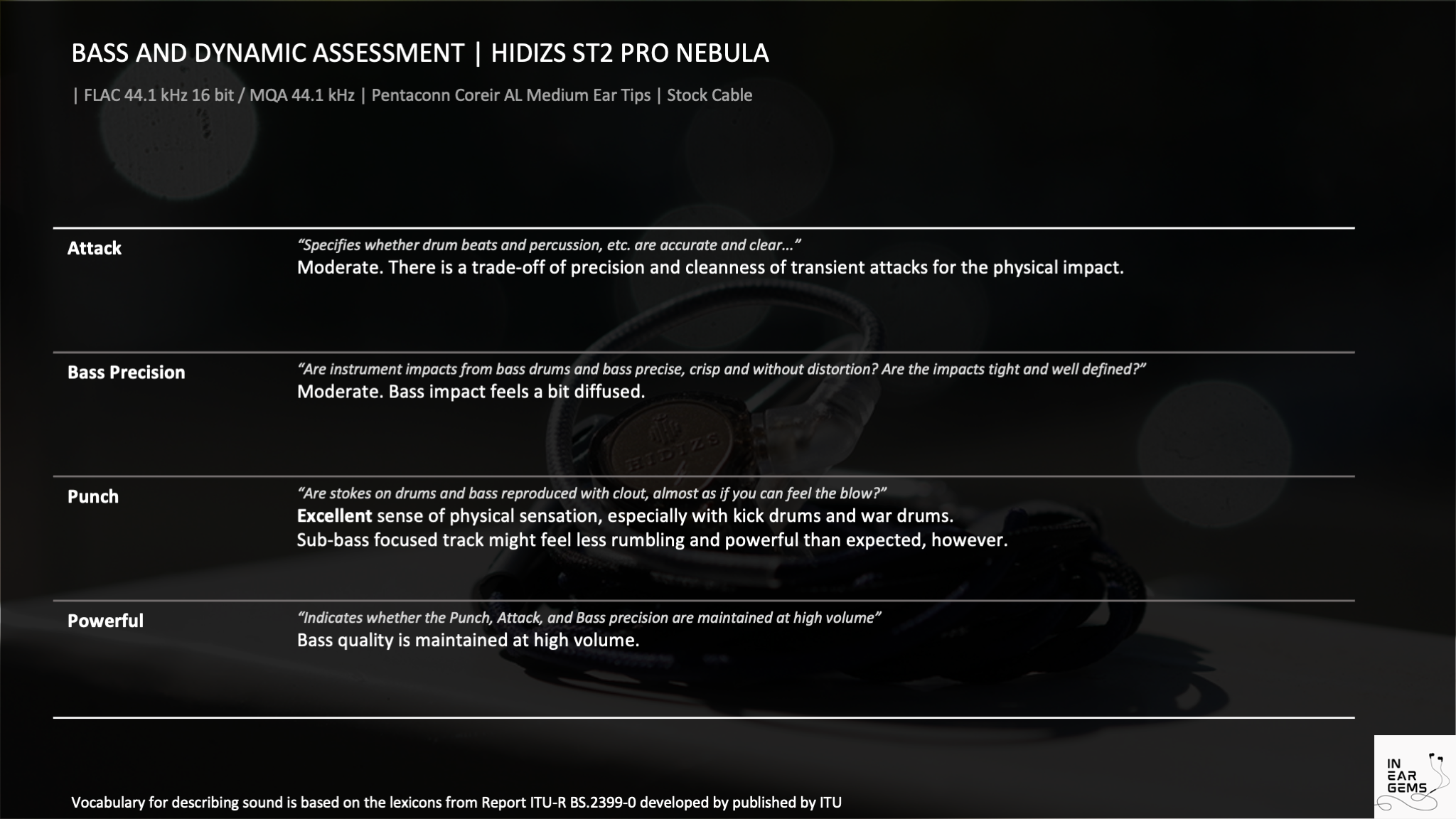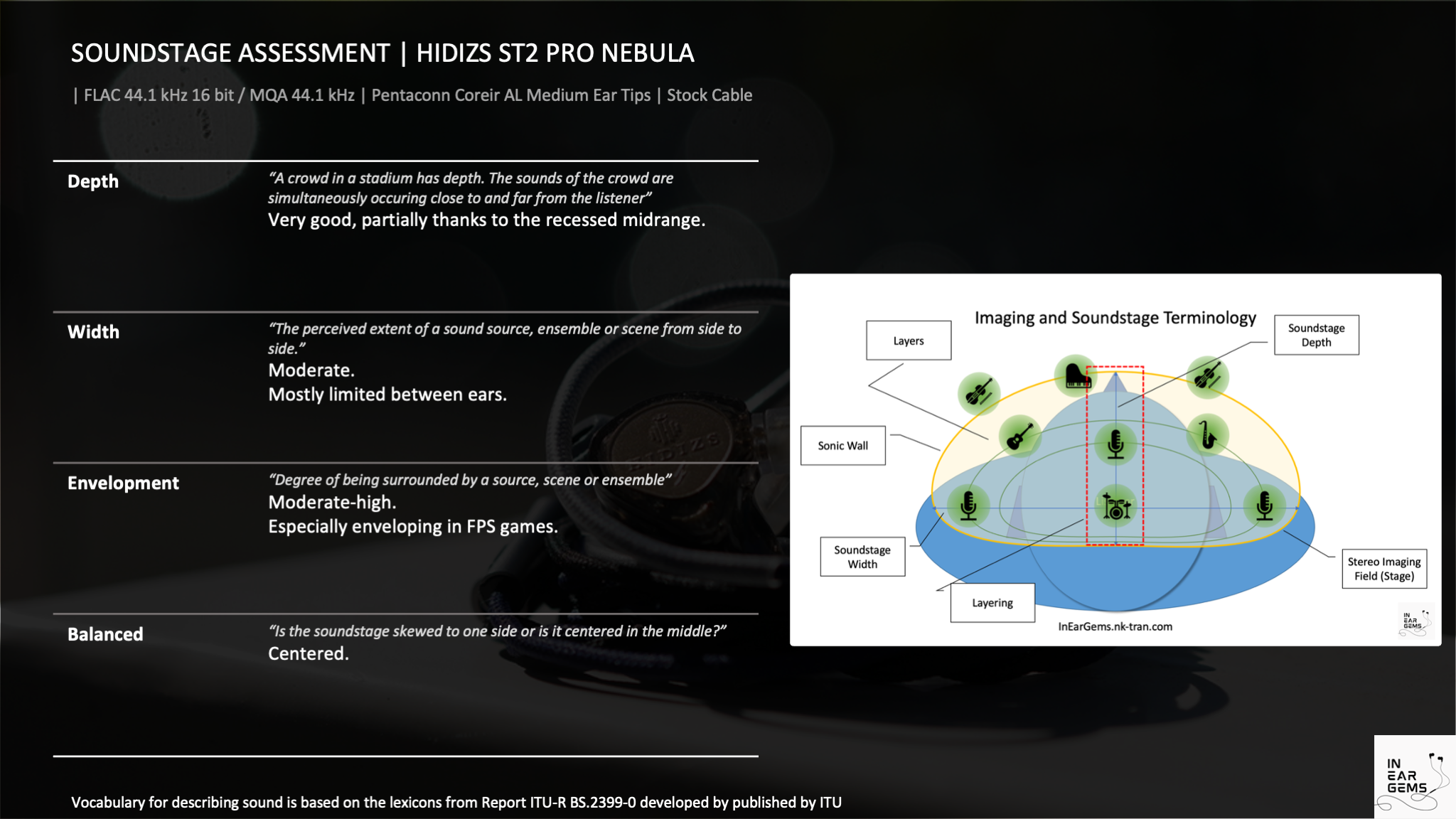Hidizs ST2 Pro Nebula - Bassy and convenient
Today, we look at a new release from Hidizs, the ST2 Pro Nebula. This IEM is an attempt to combine Hidizs expertise as an electronics manufacturer with their emerging reputation as an IEM maker.
Forewords
- What I look for in an IEM is immersion. I want to feel the orchestra around my head, track individual instruments, and hear all of their textures and details. I’m not picky about tonality, as long as it does not make the orchestra, violin, cellos, and pianos sound wrong.
- I rate IEMs within with a consistent scale from 1 (Poor) to 3 (Good) to 5 (Outstanding). An overall ranking of 3/5 or above is considered positive.
- Ranking list and measurement database are on my IEM review blog.
- The terminology for subjective impressions in this review is based on the Audio Wheel for reproduced sound defined in the technical report ITU-R BS.2399-0
- This review is based on a pre-production sample from Hidizs (Thank you!). I have no affiliation with or financial interest in Hidizs.
- This IEM would be released on Kickstarter. The campaign would be launched in December 2024 and units would be shipped in February 2025. The early bird price of the IEM is $39. Refer to Kickstarter page for more detail.
General Information

Non-sound Aspects


The earpieces of ST2 are definitely designed for cost-effectiveness. It consists of two injection molded plastic pieces snapped and glued together to form a hollow shell for the driver. On the plus side, the nozzles are constructed from metal and feature a lip to help retaining the ear tips.
Comfort-wise, I had quite a bit of problem with the stock silicone ear tips that come with my pre-production unit. Simply put, the short and soft ear tips do not work well with the relatively short nozzles of ST2, making it quite tricky to achieve a stable seal. For IEMs like ST2, in my experience, you should use ear tips with a longer stem and sticky nozzles to compenstate for the nozzle length. I opted for Pentaconn Coreir AL ear tips for the rest of my listening tests with ST2.
The key “accessory” of ST2 is, of course, the USB DAC cable. Simply put, you can think of it as an Apple dongle with built-in IEM cable. I will discuss this cable later in this review.
Sonic Performance
Timbre:





ST2 has a rather unique sound signature that does not align with any other IEM in my database. The best way to describe it is a bass-focused V-shaped sound signature. In other words, ST2 is unabashedly “casual.” It does not aim for a “neutral” “audiophile-approved” tuning nor does it aim for a sub-bass focused tuning so that “you can feel the bass without bass bleed.” No, this IEM embraces mid-bass and utilises a surprisingly capable dynamic driver to execute that vision. ST2 is punchy, thumpy, and unabashedly recessed and boomy.
At the same time, Hidizs shows restrain and maturity with the tuning of the other end of the spectrum. As a result, ST2’s upper midrange and treble are generally smooth with minimal sibilance or shoutiness. The benefit of this tuning choice is that you can turn the volume even louder to soak in that mid-bass boom boom.
Percussion, Bass, and perceived dynamic:

Bass response, particularly mid-bass, is the highlight of ST2 sound signature. The frequency response of ST2 ensures that the sounds listeners commonly associate with “bass” such as kick drums and the slaps and plucks of bass guitars are highlighted over other elements in the mix. The exaggerated amount of bass is accompanied by surprisingly competent bass quality to create impactful bass line that also feels “tight” and snappy. The only aspect where the bass of ST2 falters is the sub-bass extension. Simply put, this IEM does not “growl” or “rumble” as much as you would expect when you compare to modern IEMs with a sustained boost below 50Hz. As a result, if your music relies on sub-bass rather than mid-bass, you might find the bass somewhat lacking.
Resolution:

ST2 does not break the mold of a single DD in terms of both instrument separation and detail retrieval. Weak extension into the upper treble is an expected weakness that pulls down the perceived technical performance. The tuning choice to emphasise bass and recess the midrange also negatively impact the perceived clarity of this IEM. That said, ST2 does not fall behind the expected level of good DD from yester-years such as the venerable Moondrop Aria 2021. The snappy, tactile physical sensation from the bass also gives this IEM a slight boost in the perceived incisiveness.
Stereo imaging and soundstage:


The soundstage of ST2 is rather unusual due to its tuning. The thick mid-bass and lower-midrange emphasis does narrow down the soundstage, but exaggerates the depth illusion in return. For example, on some tracks, the front-left and front-right elements in the mix can feel like they pop out from the stage to hover slightly in front of my face, to the sides. Moreover, this IEM tends to place sound elements further toward the back of my head. It’s hard to say whether this presentation is better or worse, but it’s a bit different, making it interesting.
Where ST2 really shines is in FPS gaming. ST2 is one of the rare IEMs that can convey the illusion of gunshots coming from the front of the head. Whilst ST2 does not have tack sharp positioning of sound elements, I find this IEM to be quite competent for gaming. If you are skilled, you might be able to gain competitive advantage with ST2.
USB DAC Cable
As I mentioned, ST2 is packed with a USB DAC cable. The immediate question would be whether the cable “transparent” or it has some sorts of baked in EQ. As you can see from the frequency response measurement below, the response of ST2 remains unchanged when swapped to an analog cable. This result suggests that the USB DAC cable is “transparent.”

Regarding the DAC itself, I found the cable to sound clearer, more spacious, and more dymamic than the plain old Apple dongle. According to the official spec sheet, it seems that ESS ES9281AC PRO chip provides both DAC and amplification. The volume curve seems to be set quite aggressively, similarly to other USB DAC cables on the market, meaning this DAC gets very loud even at low volume with all of my devices, from HiBy R3II to MacBook.
Gallery
Conclusions
What I like about this IEM:
- Punchy, impactful mid-bass
- The USB DAC cable has the highest handling and comfort so far
- Interesting soundstage shape with some content
What could be improved:
- Recessed and rather boomy midrange
- Vocals lack a sense of vibrancy and “shine”








